Berkhamsted Castle
Berkhamsted Castle is a Norman motte-and-bailey castle in Berkhamsted, Hertfordshire. The castle was built to obtain control of a key route between London and the Midlands during the Norman conquest of England in the 11th century. Robert of Mortain, William the Conqueror's half brother, was probably responsible for managing its construction, after which he became the castle's owner. The castle was surrounded by protective earthworks and a deer park for hunting. The castle became a new administrative centre of the former Anglo-Saxon settlement of Berkhamsted. Subsequent kings granted the castle to their chancellors. The castle was substantially expanded in the mid-12th century, probably by Thomas Becket.
| Berkhamsted Castle | |
|---|---|
| Berkhamsted, Hertfordshire in England | |
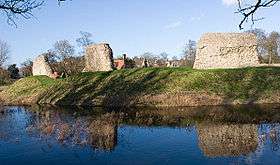 Exterior walls, seen across the moat | |
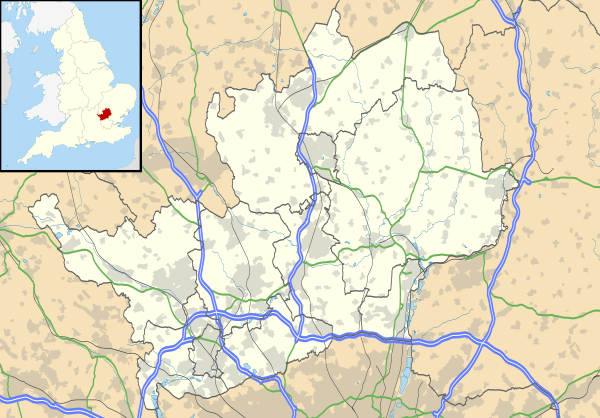 Berkhamsted Castle Shown within Hertfordshire 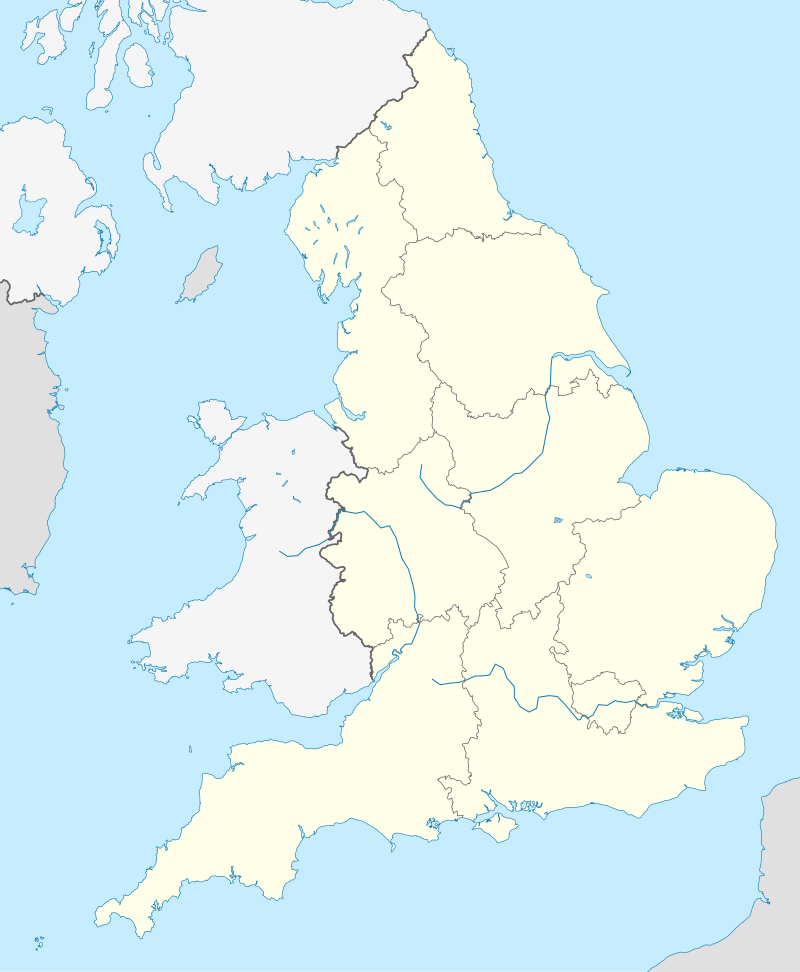 Berkhamsted Castle Berkhamsted Castle (England) | |
| Coordinates | 51°45′49″N 000°33′32″W |
| Grid reference | SP996083 |
| Type | Motte and bailey |
| Site information | |
| Owner | Duchy of Cornwall |
| Operator | English Heritage |
| Open to the public | Yes |
| Condition | Ruined |
| Website | English Heritage Berkhamsted Castle Trust |
| Site history | |
| Built | 1066 |
| Built by | Robert, Count of Mortain |
| In use | 1066–1495 |
| Materials | Stone |
| Battles/wars | 1216 Siege of Berkhamsted (First Barons' War) |
| Garrison information | |
| Past commanders | Edward the Black Prince |
| Designations | Scheduled Ancient Monument |
The castle was besieged in 1216 during the civil war between King John and rebellious barons, who were supported by France. It was successfully captured after Prince Louis, the future Louis VIII, attacked it with siege engines for twenty days, forcing the garrison to surrender. After being retaken by royal forces the subsequent year, it was given to Richard, Earl of Cornwall, beginning a long association with the Earldom of Cornwall and the later duchy. Richard redeveloped the castle as a palatial residence, and made it the centre of the earldom's administration. Edward III further developed the castle in the 14th century and gave it to his son, Edward, the Black Prince, who expanded the hunting grounds. The castle was also used to hold royal prisoners, including John II of France and rival claimants to the English throne.
In the late 15th century, the castle became increasingly unfashionable and fell into decline. By the mid-16th century, it was in ruins and unsuitable for royal use. Stone was taken from the castle to build houses and other buildings in the town. The castle was almost destroyed during the construction of the London and Birmingham Railway in the 1830s. As a result, it became the first building in Britain to receive statutory protection from Parliament. In 1930, the castle passed from the Duchy of Cornwall to the government's control. It is maintained as a tourist attraction by English Heritage.
History
1066–1217
Berkhamsted Castle was built during the Norman conquest of England in 1066. After William the Conqueror defeated the Anglo-Saxons at the Battle of Hastings he advanced from the coast, across the Thames Valley and north into Hertfordshire.[1] Chroniclers suggest that the Archbishop of York surrendered to William in Berkhamsted, and William probably ordered the construction of the castle before proceeding south into London.[2] Berkhamsted was strategically significant, as it lay on a key route into the Midlands from London through the Chiltern Hills.[1] The actual construction work was probably overseen by William's half-brother, Robert of Mortain, who owned it by the time of the writing of the Domesday Book.[3]

The castle was located slightly away from the main road, to give additional space for the earthworks involved, and was positioned as to benefit from natural springs running down from under the hill.[1] It had a motte and bailey design, with a 40 foot (12 m) high motte, and a bailey around 500 foot (150 m) by 300 foot (91 m), enclosing 0.6 acres (0.24 ha) acres. A double bank and ditch ran around the whole castle, with both sets of ditches filled with water.[4] In total, the wider earthworks occupy around 11 acres (4.5 ha).[5] A fossarius – a specialised ditch digger – was recorded as being employed maintained at the castle in 1086.[6] Radiocarbon dating of organic remains from within the castle's motte indicates a post 1066 construction date.[7][8]
A large deer park, owned by the Crown, was established around the castle to provide hunting grounds.[9] The castle was carefully positioned next to the park, which was overlooked by the motte.[10] A vineyard was also maintained alongside the castle.[11] The old Anglo-Saxon manorial centre was moved to the site, and as a result the Anglo-Saxon settlement of Berkhamsted may have shifted from the area now called Northchurch along Akeman Street to be closer to the castle; several mills, essential for grinding flour, were present there in 1086.[12]
Robert's son, William rebelled against Henry I and the castle was confiscated.[13] Henry granted Berkhamsted to his chancellor, Ranulf.[14] In 1123, however, when Ranulf was travelling to the castle with Henry, the chancellor rode over the nearby hill, became overly exhilarated at the view ahead of him and fell off his horse, dying from his injuries.[15]
The castle was subsequently given by Henry II to Thomas Becket when he became chancellor in 1155.[16] Becket extended the castle to accommodate his large household, but fell from favour in 1164 and the castle was confiscated by the king.[17] Henry II liked Berkhamsted and subsequently used it himself extensively.[18] By the mid-12th century, the castle had been rebuilt in stone, probably by Becket, with a shell keep and an outer stone wall; the bailey was divided in two by a wall to form an inner and an outer bailey.[19] A gatehouse led down into the town, meeting with Castle Street.[20] Henry II also officially recognised the surrounding settlement of Berkhamsted as a town in 1156.[1]
Under King John the castle was part of the lands forming the jointure of his second wife Isabella.[18] John entrusted the castle to Geoffrey Fitz Peter in 1206, who rebuilt much of the town.[21] Geoffrey died in 1213 and the castle passed to his son, John Fitzgeoffrey.[18]
Political tensions in England began to rise, however, and a potential conflict between King John and an alliance of rebel barons opposed to his rule began to look likely. In early 1215, King John installed a trusted German mercenary called Ranulph in charge of Berkhamsted Castle and reviewed the defensive arrangements there that April.[22] Civil war broke out later that same year. Initially, the rebels were hampered by a lack of equipment – in particular, siege engines – but in May 1216 the future Louis VIII crossed over the English Channel joining the rebel cause and being proclaimed king in London, bringing with him heavy siege equipment.[23]
King John died in October, and in December Louis besieged Berkhamsted Castle. The prince deployed his siege engines, probably trebuchets, and attacked the castle repeatedly for twenty days, throwing what chroniclers termed innumerable "damnable stones" at the defenders.[24] During the 13th century, a set of earthworks were built around the outside of the walls, which may have been the firing platforms for these trebuchets.[25][nb 1] Having put up a strong defence, the garrison was allowed to surrender and to leave with their weapons and armour.[27] When the forces loyal to the young Henry III defeated the rebels the following year, the castle was returned to royal hands.[18]
1218–1461
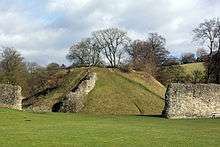
In subsequent years, Berkhamsted then became closely associated with the Earls and Dukes of Cornwall.[28] Henry III's brother, Richard, became the Earl of Cornwall and inherited the castle from his mother Isabella, and it became a permanent part of the earldom.[29] Berkhamsted was Richard's favourite castle, partially because it was conveniently close to London.[30] Richard had an impressive, three-storey tower built onto the property in 1254, and restored much of the rest of the castle; the chroniclers of nearby Dunstable complained that his building works required so many carts to carry the timber that local trade in other goods was badly affected.[31] The castle was used for the central administration of the earldom and Richard's nine stewards would submit their annual financial reports there.[32] Meanwhile, the town of Berkhamsted itself became rich as a result of the growing wool trade.[33] Richard died at the castle in 1272, and it passed to his son Edmund.[18]
The castle passed on through Edward I, who found the castle in an apparently poor condition, and his second wife, Margaret, to Edward II.[34] Edward II gave it to his royal favourite, Piers Gaveston, whom he made Earl of Cornwall.[18] Gaveston was married there in 1307, with Edward in attendance.[35] Edward II and Gaveston fell from power in 1327 and John, Edward's second son, took possession as the new Earl of Cornwall.[5]
When John died, Edward III reclaimed Berkhamsted Castle; a survey showed it to be in need of substantial repairs.[5] Edward had not yet improved Windsor Castle, so used Berkhamsted as his main property, investing considerable sums in renovating it.[18] His son, Edward, the Black Prince, was created Duke of Cornwall and also made extensive use of the castle, which formed part of the new duchy.[21] The Black Prince took advantage of the aftermath of the Black Death to extend the castle's park by 65 acres (26 ha), including some woodland pasture stretching over the Chilterns, eventually producing a park covering 991 acres (401 ha).[36] The castle was used to hold John II of France after he was taken prisoner at the Battle of Poitiers.[18] When the Black Prince fell ill following his campaigning in France, he retired to Berkhamsted and died there in 1376.[37]
Richard II inherited Berkhamsted Castle in 1377; initially the use of it was given to his favourite, Robert de Vere and, after de Vere's fall from power and exile in 1388, to John Holland.[38] Henry IV lived in the castle after he deposed Richard in 1400, and he used the property to detain rival applicants to the throne.[39] During this period Geoffrey Chaucer, later famous for his Canterbury Tales, oversaw renovation work on the castle in his role as a clerk.[40] Both Henry V and Henry VI owned the castle, the latter making use of it until his overthrow in 1461.[41]
1462–1900
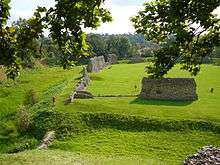
Berkhamsted was confiscated by Edward IV when he came to power during Wars of the Roses.[41] In the late 15th century, the castle was occupied by his mother, Cecily Neville, the Duchess of York.[39] By now the castle had become increasingly unfashionable, however, and was abandoned after her death in 1495.[20] By the time that antiquarian John Leland visited in the mid-16th century, it was in "much ruine" and was unsuitable for royal use.[42]
In 1580, the estate, including the ruins and the park, was leased from Elizabeth I by Sir Edward Carey, for the nominal rent of one red rose each year.[43] Stone from the castle was used to build Berkhamsted Place, a local school and other buildings in the late 16th century.[44] The castle's park, which had reached 1,252 acres (507 ha) in size by 1627, was broken up in the next two decades, shrinking to only 376 acres (152 ha).[45] The English Civil War of the 1640s largely passed Berkhamsted by, with the castle apparently playing no part in the conflict.[46]
In 1761 the wider estate and the castle were separated, the former being leased to the Duke of Bridgewater, while the latter remained in the direct control of the Duchy of Cornwall.[47] In 1863, the surrounding estates and park were sold off altogether by the duchy to Earl Brownlow; Brownlow also agreed to rent the castle from the duchy for a nominal rent.[48]
In the 1830s, plans were drawn up to build the new London and Birmingham Railway.[49] From an engineering perspective, the ideal route for the railway ran through the site of the castle, but concerns over the need to protect ancient monuments and buildings had been growing for several years, and the local Bridgwater estate were also keen to protect the local view from their buildings.[50] The castle was ultimately specifically protected in the 1833 act that sanctioned the railway, forcing the track to take a route across the valley floor. Berkhamsted was the first building in Britain to receive statutory protection from development in this way.[49] Nonetheless, the route still required the track to pass through the outer fortifications of the castle, a major engineering operation which was carried out in 1834, destroying the castle gatehouse in the process.[51]
20th – 21st centuries

The Office of Works acquired Berkhamsted Castle from the Duchy of Cornwall in 1930.[52] The inner ditch was subsequently drained of water in the 1950s.[29] In the 21st century it is operated as a tourist attraction by English Heritage, and historian Isobel Thompson considers it "one of the best surviving motte and bailey castles" in England.[20] The castle is protected by law as an ancient monument.
References
Notes
- Academic opinions vary on the interpretation of the 13th century earthworks around the castle. Historian Nigel Pounds is certain on the basis of their unusual shape that they were the French firing platforms; Adrian Pettifer is uncertain; John Goodall suggests that they were instead defensive works built later by Richard, Earl of Cornwall, arguing that it would have been unlikely that the earthworks would have been left intact outside the castle after the war.[26]
References
- Thompson, Isobel (2005), "Extensive Urban Survey – Hertfordshire" (PDF), English Heritage and Hertfordshire County Council, p. 6, retrieved 21 December 2012
- Pounds 1994, pp. 6–7; Thompson, Isobel (2005), "Extensive Urban Survey – Hertfordshire" (PDF), English Heritage and Hertfordshire County Council, p. 6, retrieved 21 December 2012
- Armitage 1912, p. 105; Brown 1989, p. 52; Pettifer 1995, p. 104
- Armitage 1912, p. 105; Brown 1989, p. 52; Pettifer 1995, p. 105; Mackenzie 1896, p. 130
- Mackenzie 1896, p. 130
- Williamson 2010, p. 218
- Jim Leary, Elaine Jamieson and Phil Stastney (2018). "Normal for Normans? Exploring the large round mounds of England". Current Archaeology (published April 2018) (337). Retrieved 4 March 2018.
- "Radiocarbon dates from 10 castle mounds – results of year 1". The Round Mounds Project. University of Reading. 7 October 2016. Retrieved 6 January 2019.
- Rowe 2007, p. 132; Thompson, Isobel (2005), "Extensive Urban Survey – Hertfordshire" (PDF), English Heritage and Hertfordshire County Council, p. 6, retrieved 21 December 2012
- Liddiard 2005, pp. 111–112
- Williamson 2010, p. 219
- Thompson, Isobel (2005), "Extensive Urban Survey – Hertfordshire" (PDF), English Heritage and Hertfordshire County Council, pp. 6, 12, retrieved 21 December 2012
- Pettifer 1995, p. 104
- Mackenzie 1896, pp. 127–128
- Liddiard 2005, p. 111; Mackenzie 1896, p. 128
- Pettifer 1995, p. 10
- "History and research, Berkhamsted Castle", English Heritage, retrieved 21 December 2012
- Mackenzie 1896, p. 128
- Brown 1989, p. 52; Thompson, Isobel (2005), "Extensive Urban Survey – Hertfordshire" (PDF), English Heritage and Hertfordshire County Council, p. 10, retrieved 21 December 2012;"History and research, Berkhamsted Castle", English Heritage, retrieved 21 December 2012
- Thompson, Isobel (2005), "Extensive Urban Survey – Hertfordshire" (PDF), English Heritage and Hertfordshire County Council, p. 10, retrieved 21 December 2012
- Thompson, Isobel (2005). "Extensive Urban Survey – Hertfordshire" (PDF). English Heritage and Hertfordshire County Council. p. 10. Retrieved 21 December 2012.; Mackenzie 1896, p. 128
- Wolstenholme 1883, p. 14
- Barlow 1999, p. 356
- Goodall 2011, p. 170; Pounds 1994, p. 109; Purton 2009, p. 325
- Pounds 1994, p. 109
- Pounds 1994, p. 111; Goodall 2011, p. 44; Pettifer 1995, p. 105
- Liddiard 2005, p. 88; Pounds 1994, pp. 6–7
- Brown 1989, p. 52
- Pettifer 1995, p. 105
- Goodall 2011, p. 189
- Goodall 2011, p. 189; Wolstenholme 1883, p. 17
- Sherwood 2008, p. 230
- Thompson, Isobel (2005), "Extensive Urban Survey – Hertfordshire" (PDF), English Heritage and Hertfordshire County Council, p. 9, retrieved 21 December 2012
- Mackenzie 1896, p. 128; Wolstenholme 1883, p. 18
- Wolstenholme 1883, p. 19
- Rowe 2007, pp. 131, 134, 142, 144
- Mackenzie 1896, pp. 128–129.
- Goodall 2011, p. 321; Mackenzie 1896, p. 129
- Mackenzie 1896, p. 129
- Pratt 2000, p. 41
- Wolstenholme 1883, pp. 22–23
- Mackenzie 1896, pp. 129–130
- Thompson, Isobel (2005), "Extensive Urban Survey – Hertfordshire" (PDF), English Heritage and Hertfordshire County Council, p. 12, retrieved 21 December 2012; Mackenzie 1896, p. 130
- Thompson, Isobel (2005), "Extensive Urban Survey – Hertfordshire" (PDF), English Heritage and Hertfordshire County Council, pp. 10, 13, retrieved 21 December 2012
- Wolstenholme 1883, pp. 46–47
- Wolstenholme 1883, pp. 45–46
- Sherwood 2008, p. 245
- Sherwood 2008, p. 245; Wolstenholme 1883, p. 26
- Richards 1995, p. 123
- Richards 1995, p. 123; Prince 2008, p. 179
- Thompson, Isobel (2005), "Extensive Urban Survey – Hertfordshire" (PDF), English Heritage and Hertfordshire County Council, pp. 10, 23, retrieved 21 December 2012
- Brown 1989, p. 53
Bibliography
- Armitage, Ella S. (1912). The Early Norman Castles of the British Isles. London, UK: John Murray. OCLC 4246535.CS1 maint: ref=harv (link)
- Barlow, Frank (1999). The Feudal Kingdom of England, 1042–1216. Harlow, UK: Pearson Education. ISBN 0-582-38117-7.CS1 maint: ref=harv (link)
- Brown, Reginald Allen (1989). Castles from the Air. Cambridge, UK: Cambridge University Press. ISBN 9780521329323.CS1 maint: ref=harv (link)
- Goodall, John (2011). The English Castle. New Haven, US and London, UK: Yale University Press. ISBN 9780300110586.CS1 maint: ref=harv (link)
- Liddiard, Robert (2005). Castles in Context: Power, Symbolism and Landscape, 1066 to 1500. Macclesfield, UK: Windgather Press. ISBN 9780954557522.CS1 maint: ref=harv (link)
- Mackenzie, James Dixon (1896). Castles of England: Their Story and Structure. 1. New York, US: Macmillan. OCLC 12964492.CS1 maint: ref=harv (link)
- Pettifer, Adrian (1995). English Castles: a Guide by Counties. Woodbridge, UK: Boydell Press. ISBN 9780851156002.CS1 maint: ref=harv (link)
- Pounds, Nigel J. G. (1994). The Medieval Castle in England and Wales: A Social and Political History. Cambridge, UK: Cambridge University Press. ISBN 978-0-521-45099-7.CS1 maint: ref=harv (link)
- Pratt, John H. (2000). Chaucer and War. Lanham, UK: University Press of America. ISBN 9780761815884.CS1 maint: ref=harv (link)
- Prince, Hugh C. (2008). Parks in Hertfordshire Since 1500. Hatfield, UK: Hertfordshire Publications. ISBN 9780954218997.CS1 maint: ref=harv (link)
- Purton, Peter Fraser (2009). A History of the Early Medieval Siege, c.450–1220. Woodbridge, UK: Boydell Press. ISBN 9781843834489.CS1 maint: ref=harv (link)
- Richards, Jeffrey (1995). "The Role of the Railways". In Wheeler, Michael (ed.). Ruskin and Environment: The Storm Cloud of the Nineteenth Century. Manchester, UK: Manchester University Press. pp. 123–143. ISBN 9780719043772.CS1 maint: ref=harv (link)
- Rowe, Anne (2007). "The Distribution of Parks in Hertfordshire: Landscape, Lordship and Woodland". In Liddiard, Robert (ed.). The Medieval Park: New Perspectives. Macclesfield, UK: Windgather Press. pp. 128–145. ISBN 978-1-9051-1916-5.CS1 maint: ref=harv (link)
- Sherwood, Jennifer (2008). "Influences on the Growth of Medieval and Early Modern Berkhamsted". In Wheeler, Michael (ed.). A County of Small Towns: the Development of Hertfordshire's Urban Landscape to 1800. Hatfied, UK: Hertfordshire Publications. pp. 224–248. ISBN 9781905313440.CS1 maint: ref=harv (link)
- Williamson, Tom (2010). The Origins of Hertfordshire. Hatfied, UK: Hertfordshire Publications. ISBN 9781905313952.CS1 maint: ref=harv (link)
- Wolstenholme, John (1883). Two Lectures on the History and Antiquities of Berkhamsted (2nd ed.). London, UK: Nichols and Sons. OCLC 693003587.CS1 maint: ref=harv (link)
Further reading
- Remfry, Paul Martin (2009). Berkhamsted Castle and the Families of the Counts of Mortain, the Earls of Cornwall and the Crown. Worcester, UK: SCS Publishing. ISBN 9781899376483.
External links
| Wikimedia Commons has media related to Berkhamsted Castle. |
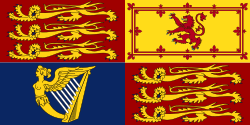
.svg.png)